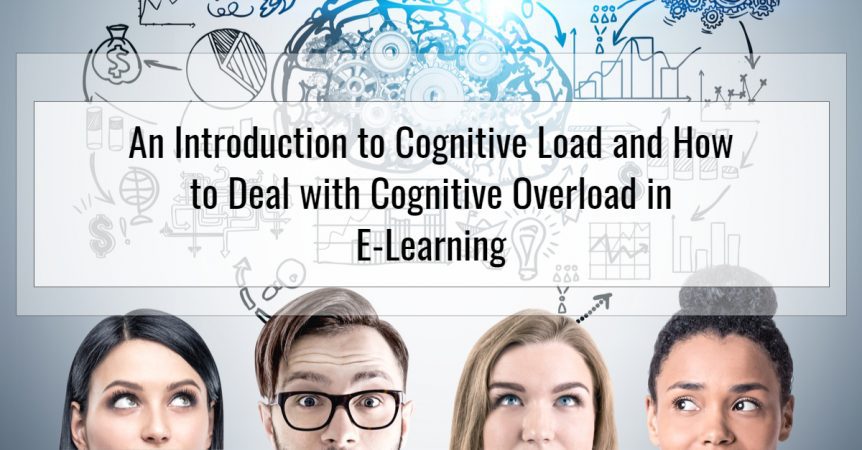An Introduction to Cognitive Load and How to Deal with Cognitive Overload in E-Learning
When you create an e-learning course, you will want people taking that course to learn something, whether it is new information or a new skill. Getting the right cognitive load balance will facilitate this learning process while getting it wrong will result in cognitive overload.
Cognitive overload is not good for you or those you want to train.
In brief, cognitive overload is where learners are asked to process more information than they can handle, whether it is because there is too much too fast, or because of the complexity of the content delivered in a short period of time.
In situations of cognitive overload, learners will struggle to understand and/or retain information. They may also feel anxious and stressed by the experience.
Cognitive Load Theory Explained
The theory of cognitive load focuses on the capacity of working memory. Working memory, or short-term memory, can only process and retain a limited amount of information at once. Long-term memory has a greater capacity, but information must be processed through your short-term memory for it to get into your long-term memory.
If you give learners too much information to think about, learn, and process, they will hit the limits of working memory, significantly impacting their ability to learn. This is known as cognitive overload.
Cognitive load is not just about content, either. The design of your e-learning course can also tip the cognitive load balance. For example, using complex language or navigational elements, or where there is distracting content, such as images with no direct relevance to the information. Even background music on videos can cause cognitive overload in some situations.
There are three different types of cognitive load:
- Intrinsic – the complexity of the information or skill.
- Extraneous – additional, non-relevant material that is included in your e-learning course that takes working memory to process.
- Germane – elements in your e-learning course that help learners use their working memory effectively.
All three combine to produce cognitive load. So long as that load is within the limits of the working memory of learners, you will get positive results. If you fall outside those limits, however, learners will end up in a cognitive overload situation.
How to Identify Cognitive Overload Problems
There are a number of steps you can take to prevent cognitive overload in your e-learning courses, but what about your existing courses? How can you identify if cognitive overload is impacting the learner experience and the performance of your course? Here are some things to look for:
Patterns in mistakes and low scores
If a large proportion of people are making the same mistakes or getting the same questions wrong, it is a good indicator there might be an issue with at least part of your e-learning course. That issue could be cognitive overload.
If you believe cognitive overload could be part of the problem, you should re-do those elements, presenting the information in a different way. You can then review your stats to see if there has been any improvement.
Dropout rates
As learners are usually in control of when they spend time going through your e-learning courses, they are likely to stop or pause the course whenever it gets too much for them. This is because situations of cognitive overload are unpleasant for many people.
If you identify patterns relating to this, (i.e., learners dropping out or stopping at similar points) you could have a problem with cognitive overload. As with the above point, it will be worthwhile re-doing the section of the course immediately before the dropouts start to occur.
Time taken to complete the e-learning course
When you create an e-learning course, you should have a fairly good idea of how long it will take learners to complete it. You could even go through the course yourself to create a benchmark.
If learners are taking longer than you thought it would take to complete the course, you might have cognitive overload issues. This is because learners could be going back over content again and again in order to get a full understanding.
Review your course objectively
You should also spend time objectively reviewing your course. When doing this, critique each element from a cognitive load perspective.
For example, are you including too much information in a single chapter or module? If the information is highly complex, does the course go through it too quickly? Is the navigation easy to use, or will the learner have to think about what they should do next? Is there anything in the course that could distract the learner? These are all things that can contribute to cognitive overload.
Feedback
Getting feedback from learners can also help you understand whether you might have a cognitive overload issue. For example, learners might tell you they were unhappy or dissatisfied with the e-learning course. You then need to drill deeper to understand why they didn’t like it. The answers to these questions could point to an issue with cognitive overload.
Optimising Your E-Learning Courses
Much of the process of minimising the potential of causing cognitive overload in learners is about making your e-learning courses as good as possible. It is also about maximising the results from your e-learning courses. In other words, the benefits of identifying and dealing with cognitive overload relate directly to return on investment and the achievement of your training objectives.
Therefore, balancing cognitive load and preventing cognitive overload should be an e-learning course optimisation priority.
